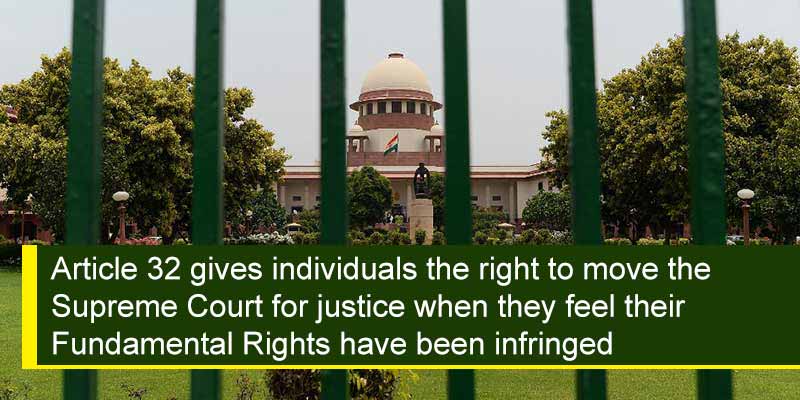- India
- Oct 18
Explainer - What is Article 32?
• A five-judge Constitution bench unanimously refused to accord legal recognition to same-sex marriage under the Special Marriage Act. However, it passed a slew of directions to stop discrimination against queer couples and said, the State has an obligation to recognise such unions and grant them benefits under law.
• Chief Justice D.Y. Chandrachud said the Supreme Court is vested with the authority to hear this case under Article 32 and it has the power to issue directions, orders, or writs for the enforcement of the Fundamental Rights.
• Article 32 gives individuals the right to move the Supreme Court for justice when they feel their Fundamental Rights have been infringed.
• The Supreme Court has in the past exercised its powers under Article 32 in respect of enforcement of various Fundamental Rights and cited certain precedents.
What is Article 32?
In Part III of the Constitution, Article 32 deals with Right to Constitutional Remedies.
It states that:
(1) The right to move the Supreme Court by appropriate proceedings for the enforcement of the rights conferred by this Part is guaranteed.
(2) The Supreme Court shall have power to issue directions or orders or writs, including writs in the nature of habeas corpus, mandamus, prohibition, quo warranto and certiorari, whichever may be appropriate, for the enforcement of any of the rights conferred by this Part.
(3) Without prejudice to the powers conferred on the Supreme Court by clauses (1) and (2), Parliament may by law empower any other court to exercise within the local limits of its jurisdiction all or any of the powers exercisable by the Supreme Court under clause (2).
(4) The right guaranteed by this article shall not be suspended except as otherwise provided for by this Constitution.
Article which has been described as the heart and soul of the Constitution
A statement of B.R. Ambedkar has been specifically reiterated in several judgments of the Supreme Court to emphasise the unique significance attributed to Article 32 in our constitutional scheme.
“If I was asked to name any particular Article in this Constitution as the most important, an Article without which this Constitution would be a nullity, I could not refer to any other Article except this one. It is the very soul of the Constitution and the very heart of it,” Ambedkar had said during the Constituent Assembly debates in 1948.
Approaching SC and HC
• When it comes to violation of Fundamental Rights, an individual can approach the High Court under Article 226 or the Supreme Court directly under Article 32.
• Article 226 of the Constitution deals with the power of High Courts to issue certain writs. The power under Article 226 to issue writs can be exercised not only for the enforcement of Fundamental Rights, but for any other purpose as well.
• Article 32 of the Constitution gives an extensive original jurisdiction to the Supreme Court in regard to enforcement of Fundamental Rights. It is empowered to issue directions, orders or writs, including writs in the nature of habeas corpus, mandamus, prohibition, quo warranto and certiorari to enforce them.
Explanation on Article 32
• The Constitution of India is unique in that its provisions expressly accord the judiciary with the power to review the actions of the legislative and executive branches of government, unlike in many other countries.
• Part III of the Constitution of India enshrines the Fundamental Rights of the people of India. Article 13 of the Constitution stipulates that the State shall not make any law which takes away or abridges the rights conferred in Part III and that any law made in contravention of this condition, shall, to the extent of the contravention, be void.
• Article 32 complements Article 13 and provides the right to a constitutional remedy for the enforcement of rights conferred by Part III.
• Article 32 makes Fundamental Rights justiciable and is worded broadly. Clause (1) of Article 32 does not place any constraints on the power of the Supreme Court to entertain claims that the rights enumerated in Part III have been violated.
• Similarly, clause (2) is worded expansively and enlarges the scope of the powers of the Court to enforce Fundamental Rights. It provides the Supreme Court with the power to issue “directions, orders, or writs”.
• It indicates that the power of the apex court is not limited to striking down an offending statute, rule, or policy. Rather, it extends to issuing directions or orders or writs for the enforcement of Fundamental Rights. Put differently, this means that the power of the Supreme Court is not only ‘negative’ in the sense that it may restrain the State from doing something which infringes upon the Fundamental Rights of people but is also ‘positive’ in the sense that it may compel the State to do something or act in a manner which gives effect to such rights.
• Therefore, the manner in which Article 32 has been drafted does not limit the powers of the Court. To the contrary, it clearly and unambiguously vests the Supreme Court with the power to conduct judicial review and give effect to the Fundamental Rights enumerated in Part III.
Manorama Yearbook app is now available on Google Play Store and iOS App Store

